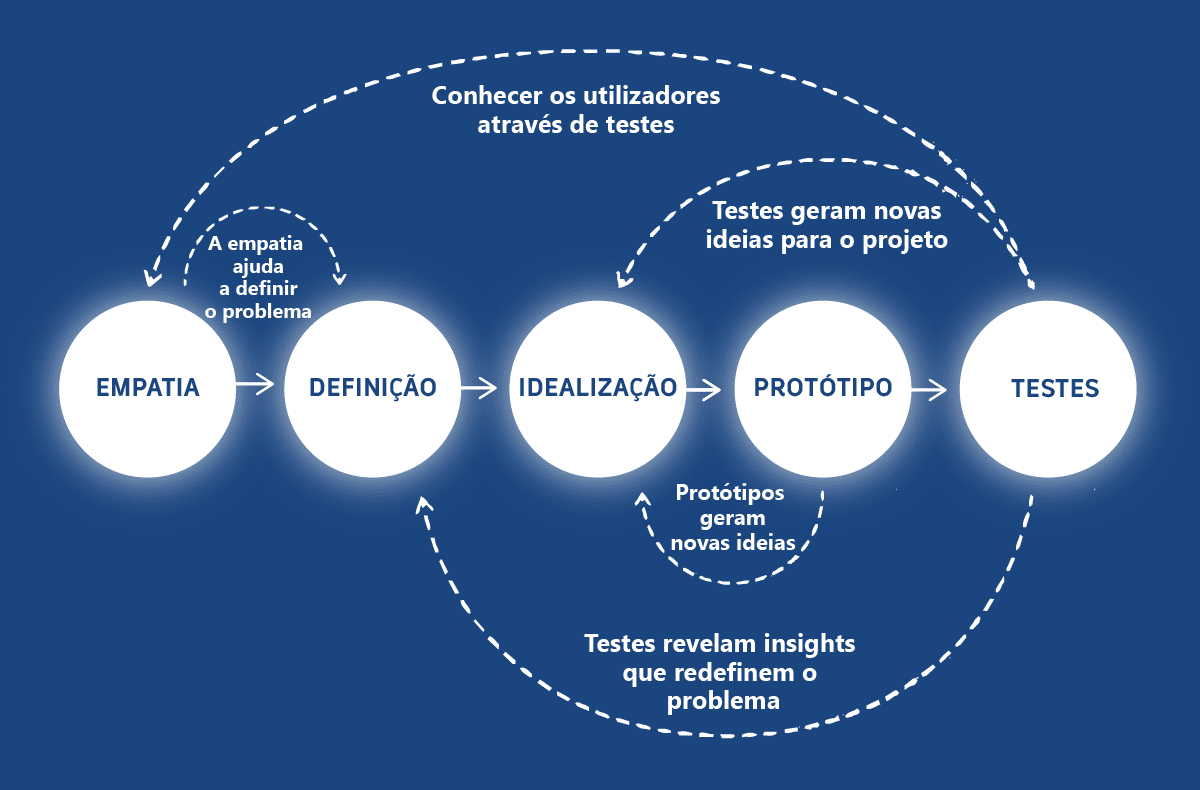So, Design Thinking is a powerful tool not just for enhancing sales strategies but also for promoting significant improvements in various aspects of life. With its focus on solving problems in innovative ways, this approach offers advantages that go beyond financial benefits.
Exploring this tool can increase your efficiency in various sectors, both personal and professional. While the process is accessible, those who want to delve even deeper can consider specialized courses and further reading.
This article will cover essential topics for anyone who wants to understand and apply DT, presenting the concepts in a practical and didactic way.
Read on to find out how you can take advantage of the countless benefits of Design Thinking in your life.
Read also: How artificial intelligence is revolutionizing sales
Mapa do Conteúdo:
ToggleWhat is design thinking?

Design thinking is a tool that solves problems by combining two crucial factors to achieve effective results.
The tool identified that it could use logic and creativity together to find solutions for a wide variety of problems.
Focus and Objectivity: Visualizing Issues with Logic
Using logic to visualize an issue results in a focus on a single line of thought, prioritizing objectivity and accuracy.
When we analyze the issue creatively, we can achieve a wider variety of results, which can be more flexible and differentiated.
The joint use of logic and creativity to analyze issues generates interesting and surprising results. When creating a new product, relying solely on logic for its functions can be limiting, lacking a differential to attract your target audience.
Considering the diversity of products on the market and the difficulty of adding something new or an item that stands out, it is necessary to use design thinking.
Logic and Creativity: Allies in Product Creation and Insertion
Creating or inserting a product in the market is a simple way to demonstrate how logic and creativity become powerful allies.
This differentiated approach makes it possible to broaden people’s vision and explore new horizons.
This approach allows you to expand your thinking and find new solutions using both logic and creativity.
Meaning of design thinking
The meaning is not complex, but a deeper analysis further facilitates the understanding of the term and how it operates in practice.
Thinking means thinking; it is not difficult to understand what this term communicates when used in conjunction with design.
Thinking cannot be separated from the application of logic; thus, it is incorporated into the name of the term, being an extremely important factor in achieving the desired results.
Thinking is essential to using logic, but differentiated results cannot be achieved without adding creativity during the process.
Design means planning, an extremely important action during the process, as thinking needs an organized impulse to reach its full potential.
By putting the words design and thinking together, we can identify in a practical and quick way how the process works, since the meanings of both have a great relationship with the term.
Plan all the steps to be taken
Design is a relevant step, as it is necessary to act with caution and plan all the steps that will be taken to achieve the best results.
Although we are talking about the meanings of design and thinking, it is important to inform that the process uses several skills and can count on the collaboration of a group of professionals working in different areas.
The great variety of design thinking is its greatest attraction, allowing it to achieve surprising results, so it is interesting to know more details about the process.
Check it out: How to create sales incentive campaigns and increase your team’s performance
Stages of design thinking
Although Design Thinking does not require a strictly fixed process to be effective, it is usually segmented into four main stages. Knowing each of these stages in detail and understanding how they operate is crucial for those who want to use this methodology efficiently.

The four stages have the following names: immersion, ideation, prototyping, and development, and are carried out in that exact sequence to maximize the effectiveness of the results.
1. Immersion
In this initial phase, the goal is to acquire a wide range of relevant information. During immersion, it is vital to develop a deep understanding of the topic at hand. Careful analysis of the problem allows us to identify all relevant information, which will be fundamental in the subsequent phases of the process.
2. Ideation
After an in-depth study during immersion, ideation involves generating innovative ideas. This stage makes intensive use of the creativity of the participants. We employ techniques such as brainstorming and the use of big data to foster ideas that can solve the identified problems.
3. Prototyping
In the third stage, we transform the ideas generated previously into testable prototypes. It is a period of experimentation and refinement, where we explore each idea through prototypes to determine its practical viability. We perform several tests to analyze the potential results of each proposed solution.
4. Development
In the last stage, we implement the most promising and tested ideas. Development not only puts the chosen solutions into practice but also highlights that, despite being the final phase, Design Thinking is a continuous cycle. The process does not end here, as the implementation of ideas can lead to new insights and further improvements.
Each of these steps facilitates the effective use of Design Thinking, so it is important to study and understand them thoroughly. This guide aims to provide a clear view of each step, allowing you to apply Design Thinking effectively and reap its many benefits.
Process
The design thinking process begins with the need to find the best ways to solve a wide variety of issues.
By carrying out all four steps of it, it will be possible to identify the best solutions and the most effective way to act to achieve all the benefits.
The process allows you to use two powerful tools, logic and creativity, to achieve surprising results when they work together.
We created the process strategically to ensure that all stages reach the full potential of the people who use it.
We divided the design thinking process into four stages that start with conducting research to identify the main needs.
After identifying various relevant pieces of information and researching the problems that need to be solved, we start using creativity.
We create ideas without limitations, without imposing barriers, to find the best ways in a logical and creative way.
The process is not complicated to execute and anyone can use design thinking to solve problems or find new ways of acting in certain situations.
What is it for?
Design thinking covers a variety of situations, making it valuable to know and integrate it into your life.
After understanding the stages of design thinking, it becomes easier to identify its applications in various situations.
It can boost sales by identifying the reasons why a product is not generating enough interest for significant profits.
By following the steps of design thinking, it is possible to find solutions to boost sales and solve problems.
It is an excellent approach to solving problems in sales, but it is also useful in other situations.
In addition, it can be used to launch new products on the market and find effective solutions to specific business problems.
The customization of solutions is the great differential of design thinking that makes its benefits extremely interesting and attractive.
Benefits of the methodology
The benefits of design thinking are extremely relevant because they are customized according to the problem that needs a solution.

It can solve several problems of professional or personal origin in an easy, strategic way, finding the best courses of action.
Its practicality of use is one of its positive points; it is not necessary to spend a large amount of money to hire specialized professionals to enjoy the benefits offered.
Although it is not necessary to hire professionals, it is possible to obtain results from a specialized team by using it as a way of solving problems.
Design thinking allows for leveraging sales of a new product or an item that has started to present problems over time.
In addition to boosting sales, design thinking can also uncover problems that are causing undesirable situations in your business.
Benefits can be personal or professional, depending on how design thinking is used. It can find solutions to various obstacles in a logical and creative way.
By using logic and creativity, it becomes easier to find effective solutions that can achieve all available results. The benefit of design thinking is to offer the user the option of using the best tools at once.
Advantages
Design thinking offers several advantages, making it a powerful and attractive tool for its users. Knowing its benefits makes it hard not to integrate the process into your routine.
One of the main advantages is that it does not require a specialized team, which results in savings. In addition, design thinking makes it easier to identify the best solutions to the problems presented.
By exploring multiple approaches, design thinking finds effective solutions, enabling a comprehensive analysis of problems and uncovering important differentiators.
This ability to find diverse solutions provides a broader view of problems, enabling more complete analysis and overcoming obstacles.
Design thinking makes it easier to overcome obstacles because it analyzes them in a logical, creative, directed, and personalized way.
It can be effectively applied in a variety of different situations, which is another of its advantages, as it will be present in the lives of many people and bring several benefits.
How to use it in the field of innovation
Using design thinking is not difficult; several people can go through the process to solve specific problems in their lives.
In addition, problems can be personal or professional. By performing the steps of design thinking, it is possible to find several different and effective solutions for each of them.
To start using design thinking, it is necessary to start the four-step process. Therefore, there is no specific formula that needs to be followed rigorously to ensure excellent end results.
It is necessary to start by doing research, studies and identifying all the important and necessary information to develop solutions to the problem.
In addition, the problem could be a drop in sales, customers giving up on a specific product, introducing a new item to the market, or any other type of issue that needs a solution.
After doing the research and identifying the problem, it is necessary to continue moving forward in the design thinking process, starting to create new ideas and think of solutions.
The steps must continue to be followed to reach the final result of design thinking. Thus, to use the tool, it is important to follow all the steps.
The use of design thinking varies according to the problem presented, as the actions taken during the development stage will be different.
When we use design thinking to launch a new product on the market, we focus on digital marketing strategies.
When we apply design thinking to improve a work environment that needs change to boost employee productivity, we focus on specific activities such as providing more comfort and adjusting schedules.
Making changes to an environment is also an application of design thinking, as it allows you to address problems related to that aspect and resolve the situation through changes.
How to use it in sales
Sales can benefit in different ways with the help of design thinking. It is necessary to analyze how the tool can be useful and start the process.
By carrying out all the steps of the design thinking process, it will be easier to succeed in creating a new product to introduce to the market.
Design thinking will be able to identify problems related to various factors that may hinder the success of the product, thus facilitating sales.
In addition to using design thinking to bring a new product to market, it is also possible to benefit in other ways that are sales-related.
For example, when sales start to decline, companies can use the steps of design thinking to identify the reason for this problem and find the best ways to resolve the issue.
Design thinking enables companies to discover how to recapture the attention of their target audience, benefiting sales when they begin to face problems.
In addition, design thinking can boost sales even when there are no obvious problems, but there is a need to increase profits.
Sales can undergo many variations, but design thinking can help when problems start to appear and cause dissatisfaction.
With design thinking, it will be possible to identify the problem logically and find a large number of ideas to solve the issue and improve sales.
Examples
Design thinking examples are varied and cover various issues. Therefore, to determine when to use the tool, it is crucial to consider whether logic and creativity can help in the situation.
Also, the simplest and easiest examples to understand are related to sales. Thus, problems with this issue are very common and often cause great discomfort.
Furthermore, being able to identify the reason for a sales problem and discover the best solution for the situation is very interesting, and this is possible with design thinking.
Design thinking can boost sales of a product that has begun to show a decline in interest from its target audience, using a variety of different solutions.
In addition to driving sales, design thinking helps companies identify growth opportunities in their field.
By analyzing the market, a company can discover ways to expand its products and services beyond its usual style.
Introducing a new product to the market is challenging, requiring attractiveness to ensure substantial sales.
With design thinking, it is possible to find more captivating ways to launch a product, differentiating it from the competition.
Design thinking is widely used in the sales world as it can deliver a large amount of efficient and profitable results.
Design thinking can also improve the work environment by helping to identify problems that affect the daily lives of employees.
In addition, it is an effective way to keep a business up to date and to seek the optimization of ideas, promoting innovation.
Books on design thinking
There are several books available on the market that offer the opportunity to increase your knowledge of design thinking.
Reading is always an interesting way to acquire more knowledge, so it can be fun to purchase books that address the subject.
Purchasing a book that teaches about a certain subject is an interesting way to learn more details about it, in addition to being able to carry out the study in your own time, it will be possible to access the information whenever necessary.
Books are not difficult to acquire and there are some interesting alternatives that approach the subject in a didactic way to facilitate your learning.
This is Service Design Thinking: Basics, Tools, Cases
One of the book alternatives available on the market is called “This is Service Design Thinking: Basics, Tools, Cases”. The writer responsible for offering knowledge on the subject is Marc Stickdorn.
Design Thinking Brazil
If you are not interested in the book, you can still acquire more knowledge by reading “Design Thinking Brazil”, written by several professionals.
Both books are excellent and have the ability to help you learn about the subject. It is worth investing in the purchase of works written for this purpose.
The second alternative book can be an excellent option for those who want to have a more practical read about design thinking, but still want to offer excellent quality and a lot of knowledge.
The first alternative book is an interesting way to learn relevant details about the subject; it is possible to know everything that is needed by reading it.
Books are a good way to learn how to carry out the process, but it is still possible to participate in courses to gain more knowledge on the subject.
Take advantage of all the opportunities available to learn about the tool, as it is a powerful tool full of benefits that can transform your personal and professional life.
Design thinking courses
Although it is not complicated to carry out the design thinking process, it is interesting to improve knowledge about the subject with the available courses.
The courses teach how to carry out all four stages of the process in a practical way, aiming to achieve the best possible final results.
In addition, it is not necessary to spend a large amount of money or spend long years studying to become a specialist in the design thinking process.
Additionally, there are free courses available, some offered online, which provides quick and convenient access to knowledge.
For example, Sebrae is one of the institutions that offer online courses on the subject at no cost to students, an option worth exploring.
If you are interested in deepening your knowledge of design thinking, you can look for other institutions that also offer courses on the subject.
In addition to Sebrae, it is possible to learn more information about the subject through the Fundação Instituto de Administração, ESPM, PUC, and IBMEC.
Therefore, choose your preferred option to acquire more knowledge about the tool, as all institutions are excellent and offer good quality to students.
Ideation
A detailed understanding of this moment is crucial to achieving design thinking results in the ideation stage.
In addition, the process encompasses the ideation stage, which represents the second phase and can only be successfully completed after the immersion stage, the first phase.
During immersion, we analyze the problems that cause undesirable situations and begin to gather all relevant information.
Subsequently, gathering all the information makes it easier to start the design thinking process, clearly identifying what needs to be done.
After acquiring all the information, ideas begin to emerge clearly and focused on finding solutions to the problem presented.
Ideation, being an important part of the process, involves creativity, being able to consider all angles and find different approaches.
Therefore, it is easier to use creativity to think of solutions after developing the logic present in the first stage of the process.
During the ideation stage, logic is still present, as ideas must be feasible and capable of generating effective solutions.
Therefore, we must conceive ideas considering the following stages, ensuring that they are feasible and capable of producing the desired results.
Innovation
The use of the tool always generates innovation, generating new ideas and updated information during the process.
The combination of creativity and logic in the tool leads to surprising results, being essential to making a big difference in various environments.
When an environment remains unchanged, the opportunity for innovation is lost, depriving it of potential benefits.
With changes implemented, innovations are more easily integrated, bringing significant benefits to the environment and its participants.
The process results in changes, acquiring updated information and generating new ideas to update the environment as needed.
These updates offer benefits, especially when we perform them strategically to identify the need for innovation and evolution.
Innovating is essential to keep up with market changes and outperform competitors, for example, so it is important to execute the process.
The process helps to keep the business up to date and focused on finding new ideas that provide a differential to the business.
It is not necessary to use the tool only to solve problems; we can also apply it to add more innovation to the environment.
Conclusion on design thinking
Design thinking can boost sales and several other results by, for example, finding the solution to problems that have become an obstacle.
To use it, it is necessary to think about how to insert the steps within the problem and create the necessary solutions to take advantage of the benefits.
It is interesting to develop more knowledge about it, as it is a way to prevent problems from disrupting your personal and professional routine.
In addition to several courses, you can also find books that can teach you about it in an easy, interesting, and effective way.
Add it to your routine and everything will start to get easier and innovation will be an important part of your life.
Finally, enjoy and read: The Main Advantages of Hiring a Sales Consultancy
Hire a B2B Business Consulting Company
Would you like to have the support of a company specialized in prospecting new clients and expanding your business opportunities?
Protagnst is a specialist in generating B2B leads and attracting corporate clients for business-to-business negotiations.
Let’s create an outbound sales funnel, for example, for your active prospecting process in order to leverage your results, generating sales predictability and making you reach higher ticket accounts.
So, don’t wait for customers to come to you, go after customers you would like to reach.
Fill out the form below, tell us a little about yourself, and together we can outline the best strategy for your business.








